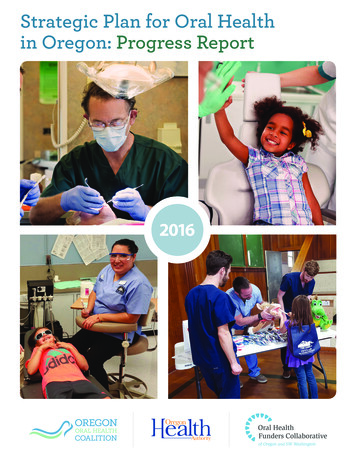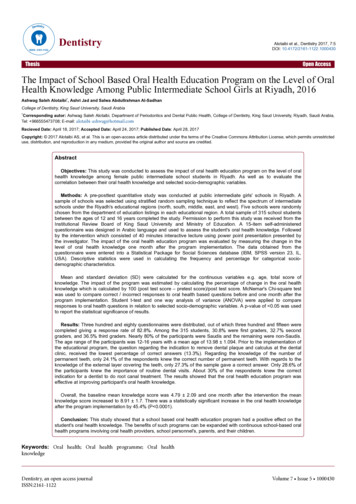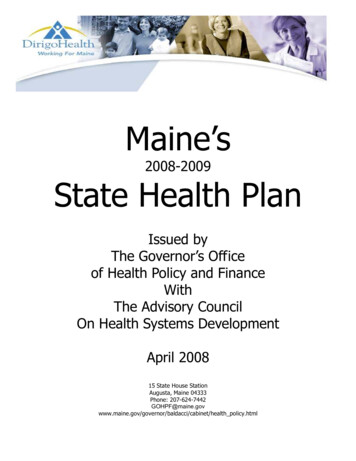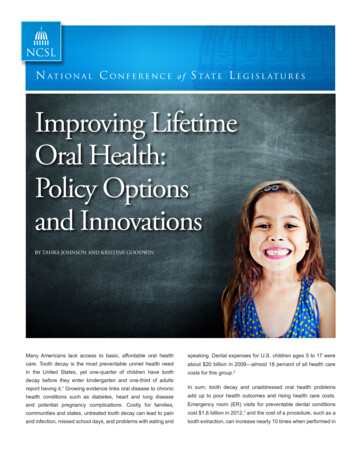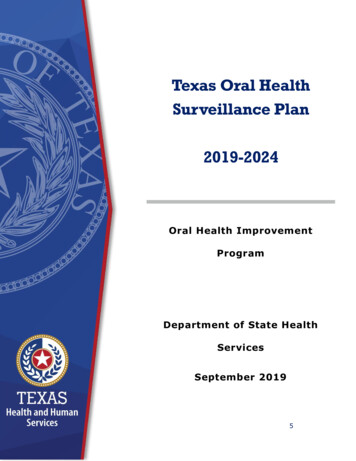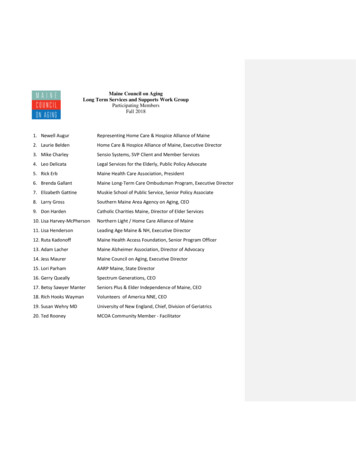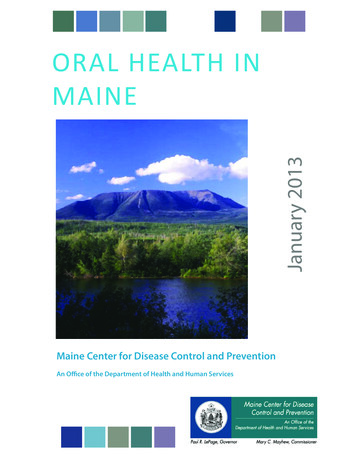
Transcription
January 2013ORAL HEALTH INMAINEMaine Center for Disease Control and PreventionAn Office of the Department of Health and Human Services
Oral Health in MaineJanuary 2013Oral Health in Maine, January 2013Department of Health and Human ServicesDr. Sheila PinetteDirector of the Maine Center for Disease Control and PreventionPrepared ByJudith Feinstein, MSPHDirector, Maine CDC OralHealth Program Maine Centerfor Disease Control andPrevention Augusta, MaineMargaret I. Gradie, PhDProgram Manager, MCD PublicHealth Augusta, MaineSara Huston, PhD AssistantResearch Professor/EpidemiologistUniversity of Southern MaineCindy Mervis, MPHEpidemiologistUniversity of Southern MaineFarooq Ghouri, MBBS, MPHFormer EpidemiologistUniversity of Southern MaineSantosh Nazare, MPHFormer EpidemiologistUniversity of Southern MaineRuthAnne Spence, PhDResearch Faculty forEvaluation University of NewEngland Research FacultyCenter for Community &Public Health Portland,MaineDenise Yob, MPHEpidemiologistUniversity of Southern MaineKatie Meyer, ScD, MPHFormer Assistant ResearchProfessor/EpidemiologistUniversity of Southern MaineKathy Phipps, DrPH DataCoordinator, Association ofState & Territorial DentalDirectorsNisha Kini, MPHFormer EpidemiologistUniversity of Southern MaineFinn Teach, MPPResearch Assistant Universityof Southern MaineSuggested citation: Oral Health in Maine, January 2013. Augusta, ME: Oral Health Program, Maine Center for DiseaseControl and Prevention, 2013.This publication was supported by the U.S. Center for Disease Control and Prevention, National Center for ChronicDisease Prevention and Health Promotion, Division of Oral Health, Cooperative Agreement Number5U58DP001591-05 (DP08-802). Its contents are solely the responsibility of the authors and do not necessarilyrepresent the official views of the US CDC.Contact InformationMaine CDC Oral Health Program11 SHS, 286 Water St. Augusta, ME 04333-0011207-287-3121 voice; 207-287-7213 faxTTY users: Dial 711 (Maine relay)Page 2
Oral Health in MaineJanuary 2013TABLE OFCONTENTSSectionPage.Executive Summary4Introduction9. . . . . . . . . . . . . . . . . . . . . . . . 12The Burden of Oral Diseases . . . . . . . . . . . . . . . . . . . . . . . . . . . . . . . . . 14Children and Youth. . . . . . . . . . . . . . . . . . . . . . . . . . . . . . . . . . . . . . . . . . 14Adults . . . . . . . . . . . . . . . . . . . . . . . . . . . . . . . . . . . . . . . . . . . . . . . . . 17Risk and Protective Factors Affecting Oral Diseases. . . . . . . . . . . . . . . . . . . 22Access to Dental Care . . . . . . . . . . . . . . . . . . . . . . . . . . . . . . . . . . . . . . . 27Dental Workforce . . . . . . . . . . . . . . . . . . . . . . . . . . . . . . . . . . . . . . . . . 30Oral Health Care Expenditures . . . . . . . . . . . . . . . . . . . . . . . . . . . . . . . . 33Conclusions and Future Considerations . . . . . . . . . . . . . . . . . . . . . . . . . . 34References . . . . . . . . . . . . . . . . . . . . . . . . . . . . . . . . . . . . . . . . . . . . . . 36Appendices . . . . . . . . . . . . . . . . . . . . . . . . . . . . . . . . . . . . . . . . . . . . . 40Appendix 1 . . . . . . . . . . . . . . . . . . . . . . . . . . . . . . . . . . . . . . . . . . . 40Appendix 2 . . . . . . . . . . . . . . . . . . . . . . . . . . . . . . . . . . . . . . . . . . . 42Appendix 3 . . . . . . . . . . . . . . . . . . . . . . . . . . . . . . . . . . . . . . . . . . . 48Appendix 4 . . . . . . . . . . . . . . . . . . . . . . . . . . . . . . . . . . . . . . . . . . . 60Appendix 5 . . . . . . . . . . . . . . . . . . . . . . . . . . . . . . . . . . . . . . . . . . . 62National and State Oral Health ObjectivesPage 3
Oral Health in MaineJanuary 2013EXECUTIVE SUMMARYINTRODUCTIONGood oral health helps to ensure overall health and well-being. Oral health is dependenton a variety of factors including diet, oral hygiene and other lifestyle choices, as well ascommunity-based preventive interventions and access to professional dental services.Anyone unable to benefit from all of these factors is at risk of experiencing poor oral health.Poor oral health has many significant social and economic consequences, as well as anadverse impact on overall health.Oral health is increasingly understood as an integral component of overall health. With thisunderstanding, there is also a recognition that poor oral health – the presence of dentaldisease and other oral conditions – is itself a risk factor for poor overall health and for otherchronic diseases and conditions. “Oral health” refers to the whole mouth and all of itsstructures, and is considerably more than just healthy teeth. Many diseases affect the healthof the mouth and manifest oral symptoms; those symptoms may be the first signs of illness orproblems elsewhere in the body.There are significant societal and personaleconomic consequences to poor oral health.For children, poor oral health can result indifficulties in learning, school attendance,and socialization, and children with poor oralhealth status are more likely to experienceproblems with oral health when they reachadulthood. It is important to note that dentalcaries (the disease that causes tooth decay orcavities) is a progressive disease. If untreated,the extent of decay increases and spreads.As the burden of untreated disease increaseswith age, caries can result in acute or chronicpain, dental abscesses, infections, and toothloss. The burden of this disease is especiallynoteworthy because it is largely preventable;the childhood years are the optimum timefor preventive measures. For adults, not onlymay people lose time from work, which mayor may not be covered by an employer’s sickleave policy, but some number of individualsfind their ability to obtain or advance inemployment limited by their oral healthstatus.The Oral Health Program of the MaineCenter for Disease Control and Prevention(Maine CDC) seeks to reduce dental diseaseand improve the oral health of all Mainecitizens by planning, implementing, andevaluating oral health promotion and diseaseprevention programs.The purpose of this report, presented bythe Oral Health Program, is to provide anoverview of current available information onthe burden of oral disease in children andadults of Maine. This report can only presentour best efforts at representing oral healthin Maine. One shortcoming is the time lagin data availability. Some of the data shownPage 4
Oral Health in MaineJanuary 2013are several years old. Thedegree of time lag differsacross information sources,and the data presented areoften from different timeperiods. During the timethis report was constructed,other reports have beenwritten and presented; thesereports, although they mayuse the same data sources,may reflect informationdifferently. For example,some data reflect point-intime information, and thedata were drawn from theirsources at different times.This report includes dataon access to care, on theprevalence of oral diseasesand oral health-related riskbehaviors, and describesthe oral health work forcein Maine. This last variablein particular is sensitive topoint-in-time data collection.The report also addressesthe oral health burden inspecific population groups,such as children with specialhealth care needs, childrenenrolled in MaineCare(Maine’s Medicaid program),pregnant women, andthose 65 years and older.To the extent possible, thereport highlights disparitiesassociated with oral health.Comparisons are made tonational data when possible,and to Healthy People 2010objectives.Since this report was firstdrafted, a number of otherreports have been compiledand published in Maine thatprovide some similar andcomplementary informationto what is included here.Please see Appendix 1 at theend of this report for a list ofrecent reports.METHODData in this report include surveillance indicators thatwere outlined in the Maine Oral Health Surveillance Plan.Indicators represent five domains: Oral diseases, including caries, periodontal disease, toothloss, oral/pharyngeal cancer, and cleft lip/palate Prevention, including dental cleaning, sealants, and waterfluoridation Risk factors, such as tobacco use Access to care, such as recent dental visits, receipt ofneeded care, reasons for not receiving care, dentalinsurance, and MaineCare claims (which include Medicaidand the State Children’s Health Insurance Program) Dental health workforce, including dentists, dentalhygienists, school-based programs, and communityhealth centers with oral health componentsThe report also used TheBurden of Oral Disease:A Tool for Creating StateDocuments provided bythe Centers for DiseaseControl and Prevention as areference guide. Indicatorsare reported for the mostrecent year of data available;trend data are also reportedfor a small number ofkey indicators. Selectindicators are presented fordemographic subgroups.More information onmethods and data sourcescan be found in Appendix 2.Page 5
Oral Health in MaineJanuary 2013USE FOR PROGRAM DEVELOPMENTThis report was created to provide oral health-related data to members of the oral healthworkforce, public health professionals, legislators, and others engaged in maintaining andimproving oral health in Maine. Such information is needed to develop and guide publichealth activities, monitor and evaluate progress, and identify disparate population groups. Inaddition, the data presented in this report can support the establishment of new priorities forsurveillance.KEY FINDINGSTooth decay among Maine childrenTooth loss among Maine adults Maine children have a significantexperience of tooth decay. In 2011, astatewide survey showed that 22% ofkindergarteners and 33% of third gradechildren had treated or untreated toothdecay. Kindergarteners and third grade childrenwhose last dental visit was more than ayear prior to the survey were significantlymore likely to have untreated tooth decaythan children who had a dental visit withinthe past year (18% vs. 13%, respectively).Although there has been someimprovement in the extent of tooth lossamong adults since the mid-1990s, in2011 more than half (51%) of all adultsin Maine had lost any (at least one) oftheir permanent teeth. Among all Maineadults, 8% had lost all of their permanentteeth; among adults 65 years and older,21% had lost all of their permanent teeth. More than half (62%) of current smokersin Maine had permanent tooth losscompared to 40% of those who neversmoked. Three out of four (75%) adultswith diabetes had lost any of theirpermanent teeth compared to 48%among those without diabetes. Among Mainers 65 years of age and older,nearly half (49.6%) of those with lessthan a high school education had lost allof their permanent teeth compared toonly 5.5% of college graduates. A similarrelationship is seen with income. Kindergarten and third grade childrenwho received free or reduced price mealsin school were significantly more likely tohave untreated tooth decay as comparedto those who did not receive school mealsupport (17% vs. 12%, respectively).Page 6
Oral Health in MaineJanuary 2013Oral and pharyngeal cancer in Maine In 2006-08, Maine’s average annualincidence rate of oral and pharyngealcancer was 12.7 per 100,000 population,higher than the U.S. rate of 10.2 per100,000 population.In 2006-08, the average annual death ratefrom oral and pharyngeal cancer was 2.4per 100,000 population, similar to the U.S.rate of 2.5 per 100,000.Access to Dental Care In 2008 (the latest year for which data areavailable), only 53% of adults in Maine haddental insurance. In 2007, there were 32,969 emergencydepartment visits among Maine residentsdue to preventable dental conditions,including untreated dental caries anddental abscesses.Preventive oral health servicesDental health workforce In 2011-12, eight out of ten (80.5%) Mainechildren ages 1-17 years old visited a dentalprofessional at least once for preventivedental care such as check-ups or dentalcleanings in the past 12 months. Maine has fewer dentists per capita thanthe U.S. overall; in 2009, Maine had 0.5dentists per 10,000 population while theU.S. overall had 0.6 dentists per 10,000population. In 2011, a high percentage of Mainekindergarteners (86%) and 3rd graders(93%) had a dental visit within the last year. In 2011, seven out of ten (68%) Maineadults had a dental visit within the pastyear.In 2011 there were 1,190 active licenseddental hygienists working in Maine, foran average of 1,116 people per practicingregistered dental hygienist in the state. Maine’s dental workforce is aging, and isnot distributed evenly across the state,compounding other issues that contributeto limitations in access to care. In 2011, one in five (21%) kindergartenersand seven out of ten (69%) third gradersin Maine had dental sealants. Nationally in1999-2004, 25.5% of children 6-9 years oldhad dental sealants placed on their molarteeth. Of those Mainers on public water supplysystems, 80% are served by optimallyfluoridated water; however, because abouthalf of Mainers get their water from privatewells, only 40% of the population hasaccess to optimally fluoridated water.Page 7
Oral Health in MaineJanuary 2013CONCLUSIONSOral Health in Maine shows that although there have been improvements inthe oral health of Maine’s residents, there are also areas of need. The datapoints to several specific areas for increased focus to address the burden oforal disease, and for further analysis and for program development. Theseinclude the following:1. A lack of dental insurance and differential access to dental care isassociated with significant untreated tooth decay among Maine children.2. There are large socioeconomic disparities in oral health, as seen in cariesexperience among children and tooth loss among adults.3. Tobacco use and diabetes are risk factors for the development of oraldisease, and are also associated with suboptimal access to preventiveservices and treatment.4. Dental workforce analysis will be important in assuring adequate accessto care for Maine people and to improving oral health status.Increased efforts in preventive interventions, control and surveillance oforal diseases and conditions, attention to workforce development anddistribution of oral health care professionals are all key elements in improvingand maintaining the oral health of Maine people.Page 8
Oral Health in MaineJanuary 2013INTRODUCTIONOral health is an integral component of overall health [1]. It includes daily activities likebrushing and flossing, regular visits to a dental professional, the use of fluoride anddental sealants, and avoidance of exposures that can lead to diseases of the teeth andgums [1]. Although oral health has typically been considered to be limited to structures of themouth and throat, there is increasing evidence that oral diseases can have systemic effectson the body. The impact of poor oral health ranges from tooth decay to tooth loss and oralcancer, and accounts for significant physical and financial costs [2].Good oral health helps to ensure overallhealth and well-being. Poor oral healthhas many significant social and economicconsequences, as well as an adverse impacton overall health.or may not be covered by an employer’s sickleave policy, but some number of individualsfind their ability to obtain or advance inemployment limited by their oral healthstatus.Oral health is increasingly understood asan integral component of overall health.Poor oral health – the presence of dentaldisease and other oral conditions – is itselfa risk factor for poor overall health and forother chronic diseases and conditions. “Oralhealth” refers to the whole mouth and allof its structures, and is considerably morethan just healthy teeth. Many diseases affectthe health of the mouth and manifest oralsymptoms; those symptoms may be the firstsigns of illness or problems elsewhere in thebody.The Oral Health Program of the MaineCenter for Disease Control and Prevention(Maine CDC) seeks to reduce oral diseasesand improve the oral health of all Mainecitizens. To carry out its mission, the OralHealth Program engages in leadership toenable communities to prevent, control andreduce oral diseases; planning, implementingand evaluating programs for oral healthpromotion and disease prevention; andstatewide coordination of communitybased oral health services through increasedaccess and removal of barriers[3]. Amongits responsibilities are surveillance of oraldiseases and accurate, reliable reporting ofdata relevant for assessing the extent andburden of oral diseases in Maine.There are significant societal and personaleconomic consequences to poor oral health.For children, poor oral health can result indifficulties in learning, school attendance,and socialization; and children with poor oralhealth status are more likely to experienceproblems with oral health when they reachadulthood. As the burden of untreateddisease increases with age, caries can resultin acute or chronic pain, dental abscesses,infections, and tooth loss. The burden of thisdisease is especially noteworthy because it islargely preventable. For adults, not only domany people lose time from work, which mayThe purpose of this report is to provide themost current information on the burdenof oral disease in children and adults ofMaine, including data on access to care,the prevalence of oral diseases and oralhealth-related risk behaviors, and the oralhealth work force in Maine. The report alsoaddresses the oral disease burden in specificpopulation groups, such as children withspecial health care needs, children enrolled inPage 9
MaineCare (Maine’s Medicaid program), pregnant women, and those 65 years and older. To theextent possible, the report highlights disparities associated with oral health. Comparisons aremade to national data when possible, and to Healthy People 2010 objectives [1] which guidedactivities and objectives during the past decade. The information provided in this report can beused to direct oral health-related programs designed to reduce the burden of oral disease, andto support collaborations with other chronic disease prevention and management and healthpromotion programs, along with collaborations with efforts in early childhood intervention, forexample. The report seeks to enhance awareness of oral health needs in Maine, and to provideinformation needed to guide efforts to prevent and treat oral diseases.DATA SOURCESData for this report were obtained from multiple sources, including telephone and writtensurveys, dental screenings, insurance claims, emergency department visit records, cancerincidence reports, death certificates, and professional licensure databases. The specific datasources used are described in Appendix 2 at the end of the report. For each data source, weprovide information on the purpose of data collection, the population sampled, data collectionmethods, and the frequency of data collection.In addition to the information provided in Appendix 2, a few general comments about data arewarranted here. It is important to note that all data have limitations and this report can onlypresent our best efforts at representing oral health in Maine. One shortcoming is the time lagin data availability. Some of the data shown are several years old. The degree of time lag differsacross information sources, and data presented are often from different time periods.Another limitation is our inability to presentstatistics for some important subgroups.Compared to many areas of the U.S., Maineis relatively homogeneous with respectto race/ethnicity, particularly among theadult population, and we generally lacksufficient numbers to allow meaningfuland stable comparisons across racial/ethnicgroups. Nonetheless, there is no reason tobelieve that the racial/ethnic disparities thathave been well-documented nationally donot apply in Maine. Also, we lack data onsubpopulations that may require specialattention in public health practice, such asthose with disabilities.The data in this report are generallyreported at the state level, though somedata are presented by county or by Maine’sPublic Health Districts. The Districts werecreated to provide a sub-state public healthinfrastructure and facilitate the delivery ofpublic health activities. Three of the Districtsare single counties: Aroostook, Cumberland,and York. Another five Districts comprisetwo or more contiguous counties andare named as follows: 1) Midcoast (Knox,Lincoln, Sagadahoc, and Waldo Counties),2) Western (Androscoggin, Franklin, andOxford Counties), 3) Penquis (Penobscot andPiscataquis Counties), 4) Downeast (Hancockand Washington Counties), and 5) Central(Kennebec and Somerset Counties). A ninthDistrict comprises Maine’s American Indiantribes.Page 10
Oral Health in MaineJanuary 2013MAINE DEMOGRAPHICSSeveral aspects of Maine’s population demographics are likely to contribute to the status oforal health in the state. Maine has a population of 1.3 million, but a land mass equal to theother five New England states combined. It is often challenging for rural communities toattract health professionals, including dentists. In Maine, it can be difficult to access dentalcare even in non-shortage areas (see the section on access for more details). However, thedifference between rural and non-rural counties is stark: in 2011, there was 1 dentist for every1,219 residents in Cumberland County, but only 1 per 4,352 in Somerset County.A second demographic consideration relevant to oral health is that many people in Maine livein poverty. In 2010-11, more than one-third (35%) of Maine’s households were at or below200% of the federal poverty level [4]. Poverty is particularly apparent among children, whoare in most need of preventive dental services. In 2011, one in five (19%) Maine childrenunder the age of 18 were living in families with incomes below the federal poverty level [5].Although MaineCare, Maine’s Medicaid program, covers dental services, Maine’s Medicaidpopulation remains underserved.Maine’s population is on average older than the rest of the nation. In 2010, Maine had thehighest median age (42.7 years) of any state in the nation [6]. Nearly one in five (17%) Mainersare 65 years of age or older, and that percentage is expected to grow over the next decade[6]. In fact, nearly all of Maine’s expected population growth through 2022 will be in the 65 year age group [6]. The need for dental services increases as people transition into old age. Inaddition to preventive care, as people age there is an increased need for specialists, such asendodontists, periodontists, and oral surgeons. Maine dentists are aging along with the restof the population, further contributing to dental workforce shortages.Although Maine’s population remains predominantly white, Maine is becoming more raciallyand ethnically diverse, especially in the younger age groups. From the 1993-94 schoolyear to the 2006-07 school year, the proportion of Maine’s students in public and approvedprivate schools who were white decreased from 98% to 95%. Between 2000 and 2008, 11%of Maine’s population growth was from international immigration. In addition to addressingwell-documented racial/ethnic disparities in health, serving the immigrant population’s oralhealth needs will require increased consideration of cultural differences.Page 11
Oral Health in MaineJanuary 2013NATIONAL AND STATEORAL HEALTHOBJECTIVESOral Health in America: A Report of the Surgeon General (the Report) alerted Americansto the importance of oral health [2]. Issued in May 2000, the Report detailed how oralhealth is promoted, how oral diseases and conditions are prevented and managed,and what needs and opportunities exist to enhance oral health. The Report noted thatpopulation disparities hinder the ability of some Americans to attain optimal oral health.The Report concluded with a framework for action, calling for a national oral health plan toimprove oral health and eliminate disparities.An oral health plan includes key indicators of oral health promotion and oral diseaseprevention. A set of national indicators was developed in November 2000 as part of HealthyPeople 2010 [1]. Healthy People 2010 is a comprehensive, nationwide health promotion anddisease prevention agenda, designed to serve as a roadmap for improving the health of allpeople in the United States during the first decade of the 21st century.The Surgeon General’s report on oral health affirmed that oral health is essential togeneral health and well-being. The report spurred a broad coalition of public and privateorganizations and individuals to generate A National Call to Action to Promote Oral Health[7]. The vision of the Call to Action is “To advance the general health and well-being of allAmericans by creating critical partnerships at all levels of society to engage in programsto promote oral health and prevent disease.” The goals of the Call to Action reflect those ofHealthy People 2010: To promote oral health To improve quality of life To eliminate oral health disparitiesPage 12
Oral Health in MaineJanuary 2013National objectives for oral health such as those in Healthy People2010 provide measurable targets. The Healthy People 2010 oral healthobjectives for the nation and the current status of each indicator forthe United States and for Maine are summarized in Table 1 (for the fulltable see Appendix 3, Table 1).Table 1. Healthy People 2010 Oral Health ObjectivesHealthy People 2010 ObjectiveTarget(%)National a(%)Maine g(%)919 aNA21-2) Untreated caries (tooth decay)a) Young children, aged 2-4 yearsa17.6 * bb) Children, aged 6-8 years2129c) Adolescents, aged 15 years1518 aNA1528aNA21-3) No tooth loss, aged 35–44 years4038 a63.0 c21-4) Edentulous (toothless), aged 65–74 years2224 a18.3 c411448 d16 aNANA2.73.0 c *2.5 e5032 f27.45021f7569 f84 g6631 a32 hd) Adults, aged 35-44 years21-5) Periodontal (gum) diseases, aged 35–44 yearsa) Gingivitisb) Destructive periodontal (gum) diseases3-6) Oral and pharyngeal cancer death rates (per 100,000population)21-8) Dental sealantsa) Children, aged 8 years (1st molars)b) Adolescents (1st and 2nd molars) aged 14 years21-9) Population served by fluoridated water systems, all21-12) Low-income children and adolescents receivingpreventive dental care during past 12 months, aged 0–18 yearsNANA: Data not available*Age adjusted to the year 2000 standard populationa: Data are for 2004b: 2009-2010 Maine Integrated Youth Health Surveyc: 2008 Behavioral Risk Factor Surveillance Systemd: Data are for 1988–1994.e: 2007 Maine Death Data.f: Data are for 2006.g: Target revised.Data Sources:2010 Maine Integrated Youth Health Survey,2008 Behavioral Risk Factor Surveillance System2007 Maine Death Data2009 Maine Integrated Youth Health SurveyWater Fluoridation Reporting SystemNational Survey of Children’s Health2007 MaineCare DataNote: Teeth cleaning data are required in the burden report. Teeth cleaning is a NOHSS indicator but are not included in Healthy People 2010. See Part V, Section D, “Preventive Visits,” in thisreport.Page 13
Oral Health in MaineJanuary 2013THE BURDEN OFORAL DISEASESThe Maine Oral Health Surveillance System wasestablished to track and report on key indicators relatedto oral health across the life span. We will report hereon indicators that describe the current status of oral healthamong children and adults in Maine, as well as on disparitiesin oral health status. Dental caries, tooth loss, cleft lip/palate,and cancer of the oral cavity and pharynx are addressed inthis report.CHILDREN & YOUTHCARIESDental caries (the disease that results in toothdecay and cavities) is a significant publichealth concern. In the United States, dentalcaries affects 60-90% of school-age childrenas well as many adults [8-10]. Untreated orpoorly controlled dental caries can lead totooth loss or complications such as dentalabscesses.decay) remains a challenge among children,especially those without access to oral healthcare [8-12].Preventive care decreases the likelihoodof caries. In recent years, there has been adownward trend in caries among childrendue to public health measures such as theeffective use of fluorides, sealants, andself-care practices. However, caries (toothAlso, in 2009, Maine’s American IndianTribes participated in an oral health surveyconducted by the Nashville Area IndianHealth Service. The survey assessed oralhealth status of children 2-5 and 8-10 yearsold [11].The 2011 Maine Integrated Youth HealthSurvey (Youth Health Survey) provides dataon the oral health status of Maine childrenand youth.Page 14
Oral Health in MaineJanuary 2013Results from the 2011 YouthHealth Survey indicate that22% of kindergarteners and33% of third grade childrenhad dental caries experience,including treated anduntreated tooth decay. Incomparison, similar Mainedata from 1998-1999 showedthat 45% of third graders hadcaries experience, indicatingan improvement over the pastdecade (Figure 1).Figure 1. Caries Experience Among 3rd Graders, Maine, 1999-2011100Percentageof3rdGradersTotal caries /ethnic disparities are also apparent intooth decay experience. For example, theNashville Area Indian Health Service surveyrevealed that 55% of 2-5 year old childrenin the Nashville Area had tooth decayexperience; this percentage increased to 75%among 8-10 year old children [11]. This datadescribes all the children surveyed, and doesnot specifically identify Maine children [11].Figure 2. Untreated Caries among Kindergarten and 3rd GradeChildren, Maine, 201140PercentageofchildrengradesKand3In 2011, 13% of kindergartenersand 15% of third graders inMaine had untreated caries.Maine kindergarten and thirdgrade children who received freeor reduced price meals in schoolwere significantly more likely toh
Public Health Portland, Maine Finn Teach, MPP Research Assistant University of Southern Maine Denise Yob, MPH Epidemiologist University of Southern Maine Maine CDC Oral Health Program 11 SHS, 286 Water St. Augusta, ME 04333-0011 207-287-3121 voice; 207-287-7213 fax TTY users: Dial 711 (Maine relay) Prepared By Contact Information Page 2
